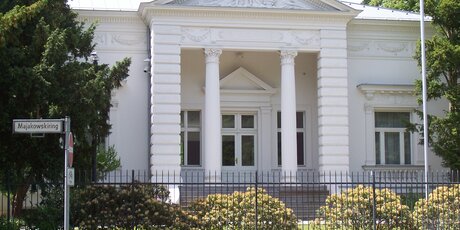Majakowskiring
The ring formed in Niederschönhausen by the old Viktoriastraße and Kronprinzstraße streets was so named after the Russian poet Majakowski (1893-1930).
s it was not allowed to access the prohibited area without a special authorization, it received the name “Städtchen” (little town), according to the Russian translation.
In 1945 the bourgeois villas on the Viktoriastraße and Kronprinzenstraße were seized and evacuated by the Soviet occupying forces for officials and personalities that emigrated. After the founding of the GDR in 1949, high-level officials of the SED and the GRD government resided in this fenced-in, and later walled-in, residential neighbourhood.
In the villa no. 28 (demolished in 1975) lived the SED Secretary-General Walter Ulbricht (1893-1973). His wife, Lotte Ulbricht (1903-2002), moved into house no. 12 after the death of his husband in 1973. In house no. 29 lived GDR President Wilhelm Pieck, in no. 34 the poet and culture minister Johannes R. Becher (1891-1964) and in no. 58 lived temporally Erich Honecker (1912-1994), member of the SED Politburo. In the Homeyerstraße street 13 lived Arnold Zweig (1887-1968), writer and president of the GDR Art Academy. Novelist Hans Fallada (1893-1947) lived in a street that would later be named after him in 1994, Rudolf-Dietzen-Weg 19, formerly Majakovskiweg, Eisenmengerweg and Prinz-Heinrich-Straße.
In 1960 the SED leadership moved its headquarters to the Waldsiedlung complex, in Wandlitz, to the north of Berlin.
Tip: The exhibition“Die Pankower Machthaber” in thegatehouses of the Schönhausen Palacedocumentsthe history of the area around the SchönhausenPalaceafter 1945
